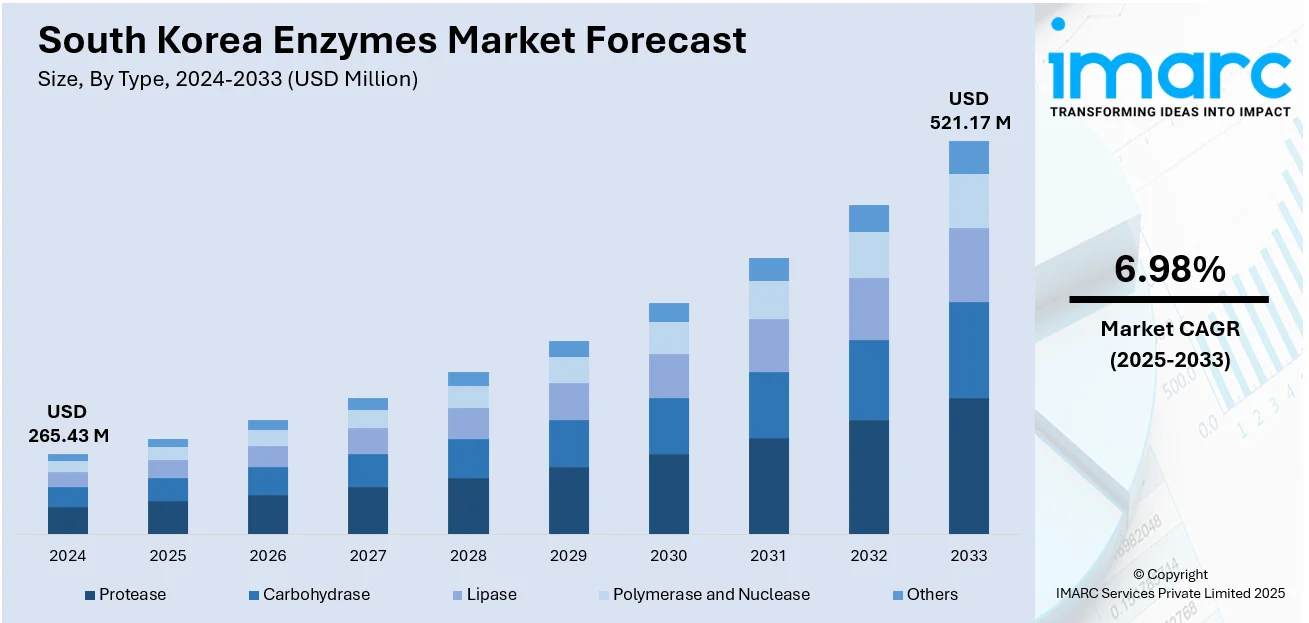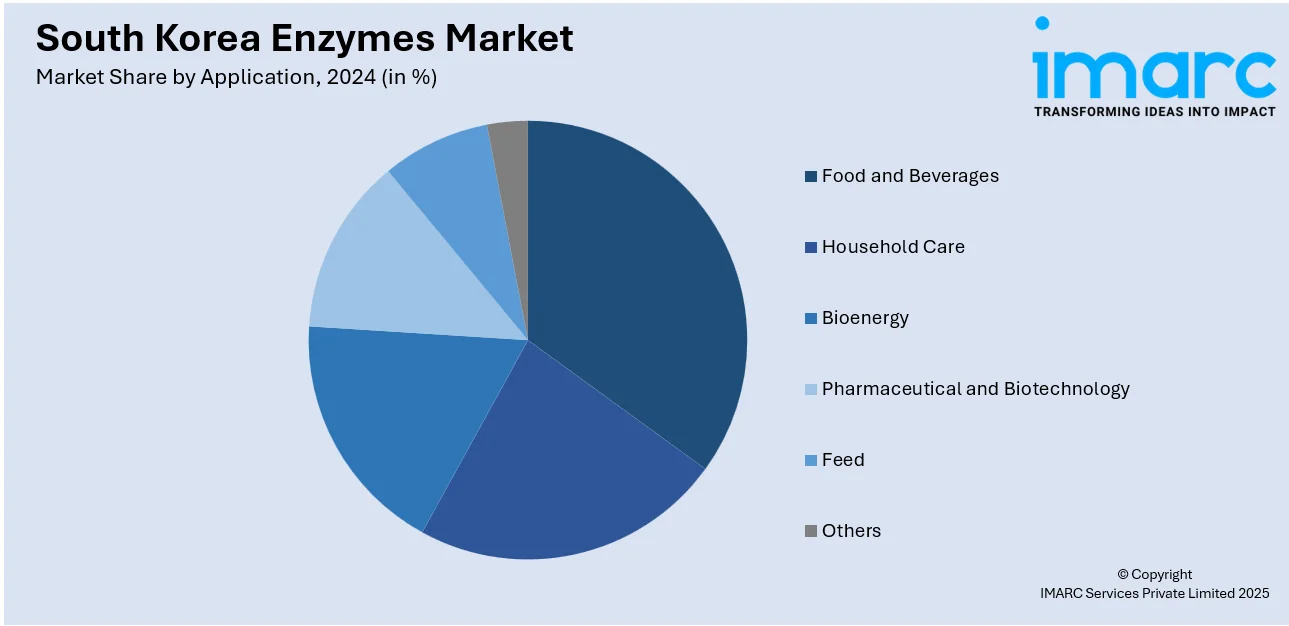
South Korea Enzymes Market Size, Share, Trends and Forecast by Type, Source, Reaction Type, Application, and Region, 2025-2033
South Korea Enzymes Market Overview:
The South Korea enzymes market size reached USD 265.43 Million in 2024. Looking forward, IMARC Group expects the market to reach USD 521.17 Million by 2033, exhibiting a growth rate (CAGR) of 6.98% during 2025-2033. The enzymes market in South Korea is gaining momentum through rising demand for digestive health supplements among seniors and advancements in enzyme therapeutics. Backed by biotech innovation and consumer trends, the market is expanding its footprint in health, wellness, and pharmaceutical applications, boosting the overall South Korea enzymes market share.
|
Report Attribute
|
Key Statistics
|
|---|---|
|
Base Year
|
2024
|
|
Forecast Years
|
2025-2033
|
|
Historical Years
|
2019-2024
|
| Market Size in 2024 | USD 265.43 Million |
| Market Forecast in 2033 | USD 521.17 Million |
| Market Growth Rate 2025-2033 | 6.98% |
South Korea Enzymes Market Trends:
Rise in Geriatric Population and Digestive Health Products
South Korea's growing elderly population is driving the demand for enzyme-based digestive health products. According to the 2024 Statistics on the Aged, people aged 65 and older currently constitute 19.2% of the population, a rate anticipated to exceed 20% in 2025 and hit 30% by 2036. This demographic shift has direct effects on the health supplement industry, particularly concerning digestion-related aspects. Elderly individuals generally generate a lower quantity of digestive enzymes, impacting nutrient absorption and potentially leading to gastrointestinal issues. In reaction, local businesses are broadening their product offerings with enzyme-enhanced formulas that aid lactose digestion, protein breakdown, and overall gut wellness. These items are designed for convenience, frequently offered in capsule, powder, or liquid formats with clear labeling. The rise of e-commerce and pharmacy distribution is making them highly accessible. Brands are capitalizing on the cultural popularity of fermented foods, such as kimchi and doenjang, that inherently feature enzymes, combining traditional styles with added advantages. This alignment of consumer behaviors and contemporary health solutions is aiding enzymes in establishing enduring popularity among the elderly. Caregivers and elderly individuals are increasingly taking initiative in preventive care, seeking convenient and effective non-prescription alternatives. The convergence of demographic needs, cultural practices, and focused product innovation is establishing enzyme-based digestive aids as a steadily expanding sector in South Korea’s health and wellness industry.

To get more information on this market, Request Sample
Advancements in Enzyme Therapeutics
The growing emphasis on ribonucleic acid (RNA) interference (RNAi) technologies is contributing to the South Korea enzymes market growth, especially within the pharmaceutical and biotech industries. RNAi allows for accurate silencing of targeted genes, including those that code for enzymes involved in metabolic and inflammatory conditions. This is creating a new avenue for targeting enzymes at the genetic level, providing improved specificity and fewer off-target effects than traditional therapies. Biotech companies in South Korea are investing in RNAi technologies to tackle diseases that have few treatment choices, particularly those related to enzyme malfunctions in the liver, cardiovascular system, and metabolic pathways. The local ecosystem, which is backed by cutting-edge genomic studies, simplified regulations, and collaborations with international pharmaceutical firms, is fast-tracking early development and clinical testing. This momentum is also catalyzing the demand for assays related to enzymes, profiling of biomarkers, and technologies for delivery. With RNAi therapies progressing from research to market, their combination with enzyme-targeting methods is anticipated to transform treatment benchmarks for numerous chronic illnesses. In line with this trend, in 2025, South Korea’s OliX Pharmaceuticals signed a $660 million global licensing deal with Eli Lilly to develop OLX75016, a Phase 1 RNAi candidate targeting the MARC1 enzyme for treating metabolic-associated steatohepatitis (MASH) and related diseases. The collaboration aims to advance innovative therapies addressing liver and cardiometabolic conditions.
South Korea Enzymes Market Segmentation:
IMARC Group provides an analysis of the key trends in each segment of the market, along with forecasts at the country and regional levels for 2025-2033. Our report has categorized the market based on type, source, reaction type, and application.
Type Insights:
- Protease
- Carbohydrase
- Lipase
- Polymerase and Nuclease
- Others
The report has provided a detailed breakup and analysis of the market based on the type. This includes protease, carbohydrase, lipase, polymerase and nuclease, and others.
Source Insights:
- Microorganisms
- Plants
- Animals
A detailed breakup and analysis of the market based on the source have also been provided in the report. This includes microorganisms, plants, and animals.
Reaction Type Insights:
- Hydrolase
- Oxidoreductase
- Transferase
- Lyase
- Others
The report has provided a detailed breakup and analysis of the market based on the reaction type. This includes hydrolase, oxidoreductase, transferase, lyase, and others.
Application Insights:

- Food and Beverages
- Household Care
- Bioenergy
- Pharmaceutical and Biotechnology
- Feed
- Others
A detailed breakup and analysis of the market based on the application have also been provided in the report. This includes food and beverages, household care, bioenergy, pharmaceutical and biotechnology, feed, and others.
Regional Insights:
- Seoul Capital Area
- Yeongnam (Southeastern Region)
- Honam (Southwestern Region)
- Hoseo (Central Region)
- Others
The report has also provided a comprehensive analysis of all the major regional markets, which include Seoul Capital Area, Yeongnam (Southeastern Region), Honam (Southwestern Region), Hoseo (Central Region), and others.
Competitive Landscape:
The market research report has also provided a comprehensive analysis of the competitive landscape. Competitive analysis such as market structure, key player positioning, top winning strategies, competitive dashboard, and company evaluation quadrant has been covered in the report. Also, detailed profiles of all major companies have been provided.
South Korea Enzymes Market News:
- In May 2025, Jack Daniel’s announced the launch of its premium aged whiskeys, including the 10-Year-Old and Bonded Rye, in South Korea to expand its market presence. Master Distiller Chris Fletcher the traditional use of enzymes from 1938 in its unique charcoal mellowing process that filters whiskey for smoothness and flavor.
- In December 2024, researchers from the Korea Bioinformation Center announced they successfully mass-cultivated enzymes from honeybee moths that can break down regular plastic, using yeast and insect cells. This eco-friendly enzyme-based method offered a new way to tackle plastic waste beyond biodegradable plastics. Their findings, published in the Journal of Hazardous Materials, revealed the enzyme’s decomposition principles enhanced by AI and genetic modification.
South Korea Enzymes Market Report Coverage:
| Report Features | Details |
|---|---|
| Base Year of the Analysis | 2024 |
| Historical Period | 2019-2024 |
| Forecast Period | 2025-2033 |
| Units | Million USD |
| Scope of the Report | Exploration of Historical Trends and Market Outlook, Industry Catalysts and Challenges, Segment-Wise Historical and Future Market Assessment:
|
| Types Covered | Protease, Carbohydrase, Lipase, Polymerase and Nuclease, Others |
| Sources Covered | Microorganisms, Plants, Animals |
| Reaction Types Covered | Hydrolase, Oxidoreductase, Transferase, Lyase, Others |
| Applications Covered | Food and Beverages, Household Care, Bioenergy, Pharmaceutical and Biotechnology, Feed, Others |
| Regions Covered | Seoul Capital Area, Yeongnam (Southeastern Region), Honam (Southwestern Region), Hoseo (Central Region), Others |
| Customization Scope | 10% Free Customization |
| Post-Sale Analyst Support | 10-12 Weeks |
| Delivery Format | PDF and Excel through Email (We can also provide the editable version of the report in PPT/Word format on special request) |
Key Questions Answered in This Report:
- How has the South Korea enzymes market performed so far and how will it perform in the coming years?
- What is the breakup of the South Korea enzymes market on the basis of type?
- What is the breakup of the South Korea enzymes market on the basis of source?
- What is the breakup of the South Korea enzymes market on the basis of reaction type?
- What is the breakup of the South Korea enzymes market on the basis of application?
- What is the breakup of the South Korea enzymes market on the basis of region?
- What are the various stages in the value chain of the South Korea enzymes market?
- What are the key driving factors and challenges in the South Korea enzymes market?
- What is the structure of the South Korea enzymes market and who are the key players?
- What is the degree of competition in the South Korea enzymes market?
Key Benefits for Stakeholders:
- IMARC’s industry report offers a comprehensive quantitative analysis of various market segments, historical and current market trends, market forecasts, and dynamics of the South Korea enzymes market from 2019-2033.
- The research report provides the latest information on the market drivers, challenges, and opportunities in the South Korea enzymes market.
- Porter's five forces analysis assist stakeholders in assessing the impact of new entrants, competitive rivalry, supplier power, buyer power, and the threat of substitution. It helps stakeholders to analyze the level of competition within the South Korea enzymes industry and its attractiveness.
- Competitive landscape allows stakeholders to understand their competitive environment and provides an insight into the current positions of key players in the market.
Need more help?
- Speak to our experienced analysts for insights on the current market scenarios.
- Include additional segments and countries to customize the report as per your requirement.
- Gain an unparalleled competitive advantage in your domain by understanding how to utilize the report and positively impacting your operations and revenue.
- For further assistance, please connect with our analysts.
 Request Customization
Request Customization
 Speak to an Analyst
Speak to an Analyst
 Request Brochure
Request Brochure
 Inquire Before Buying
Inquire Before Buying




.webp)




.webp)












